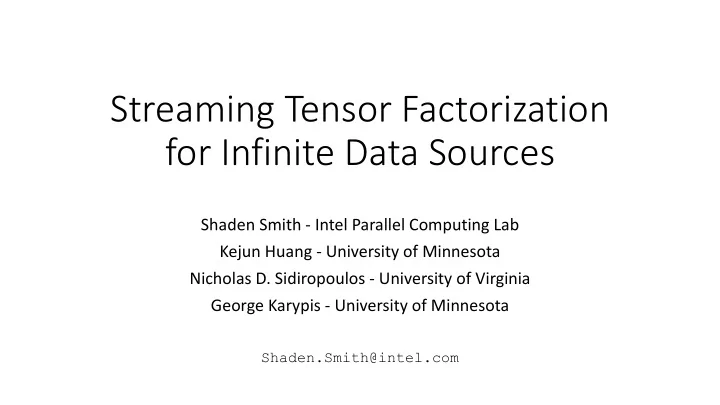

Streaming Tensor Factorization for Infinite Data Sources Shaden Smith - Intel Parallel Computing Lab Kejun Huang - University of Minnesota Nicholas D. Sidiropoulos - University of Virginia George Karypis - University of Minnesota Shaden.Smith@intel.com
Tensor factorization • Multi-way data can be naturally represented as a tensor . • Tensor factorizations are powerful tools for facilitating the analysis of multi-way data. • Think: singular value decomposition, principal component analysis. Port Port Source IP Destination IP Source IP Destination IP Canonical Polyadic Decomposition
Streaming data • We often need to analyze multi-way data that is streamed . • Applications include: cybersecurity, discussion tracking, traffic analysis, video monitoring, … • A batch of data arrives each timestep 1, …, T. • T may be infinite! • Batches are assumed to come from the same generative model. • In practice, we must account for the model slowly changing over time. Source IP Source IP Source IP ... Port Port Port Destination IP Destination IP Destination IP Time 1 Time 2 Time T
Streaming tensor factorization • The collection of N -dimensional tensors can be viewed as an (N+1) - dimensional tensor observed over time. • We want to cheaply update an existing factorization each timestep to incorporate the latest batch of data. • Challenge: storing historical tensor or factorization data that grows with time is infeasible. • Challenge: we would like to apply constraints such as non-negativity to the factorization. T T
CP-stream: optimization problem • We start from the following non-convex optimization problem over all timesteps: • We constrain the factor matrices to have column norms ≤ 1 . • This improves stability due to a scaling ambiguity in the CPD. • The # $ ∈ ℝ ' vectors form the rows of ( , the temporal factor matrix.
CP-stream: formulation • To avoid storing historic tensor data, we follow (Vandecappelle et al. 2017) and instead use the historical factorization: • ! is a forgetting factor used to down-weight the importance of older data. • Limitation: this still requires " ∈ ℝ % × ' .
CP-stream: algorithm (details in paper/poster) When a new batch of data arrives at time ! : 1. Compute " # . This has a closed-form solution involving the new batch of tensor data and the previous factor matrices. • Complexity does not depend on T. 2. Update the factor matrices. We use alternating optimization with ADMM (AO-ADMM; Huang & Sidiropoulos 2016). • The temporal factor $ is only used in its compact Gramian form $ % $ , which is computed recursively:
Extensions • CP-stream supports additional constraints/regularizations. For stability, they are combined with the column norm constraint ( proof of convergence in paper ). • Non-negativity • ℓ " regularization to promote sparse factors • Tensor sparsity: • CP-stream scales linearly in the number of non-zeros and makes use of the existing optimized kernels. • Sparsity is not treated as missing , because absence of activity also carries meaning in our applications.
Evaluation • We generated a dense 10 10 100x100x1000 tensor from rank- Online-CP Scaled estimation error Online-SGD 10 factors (plus noise). CP-stream 10 5 • We compare against: • Online-CP (Zhou et al., 2016) • Online-SGD (Mardani et al., 2015) 10 0 • Shown is the estimation error of the known ground-truth factors: 10 -5 0 200 400 600 800 1000 t
Case study: discussion tracking • Comments on reddit.com form a ( user, community, word) tensor. • A new batch arrives each day. • 65M non-zeros over one year. • Each user, community, and word are represented by a low-rank vector in the factorization. • Tracking the vectors representing the word “Obama” and the stocks community reveals events in 2008.
Wrapping up • Streaming tensor factorization has applications in areas such as cybersecurity, discussion tracking, and traffic analysis. • CP-stream uses a formulation suitable for long-term streaming, and supports sparsity and constraints. • Our source code is to be open sourced as part of SPLATT • https://github.com/ShadenSmith/splatt • Sparse tensor datasets available in FROSTT: • http://frostt.io/ • Contact: Shaden.Smith@intel.com or shaden@cs.umn.edu
Backup
AO-ADMM
AO-ADMM (2)
Recommend
More recommend